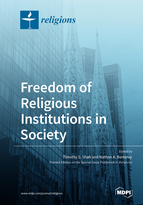Freedom of Religious Institutions in Society
A special issue of Religions (ISSN 2077-1444). This special issue belongs to the section "Religions and Health/Psychology/Social Sciences".
Deadline for manuscript submissions: closed (20 April 2021) | Viewed by 42282
Special Issue Editors
Interests: religious freedom; religious and political dynamics in theory, history, and contemporary practice; comparative politics with focus socio-political developments on religious freedom across South & Southeast Asia
Special Issue Information
Dear Colleagues,
This series seeks articles that address one or a combination of the following questions on the critical issue of the freedom of religious institutions in society:
- What is institutional religious freedom?
- How is institutional religious freedom faring in the world at the moment? Where is it flourishing? Where is it declining?
- Why should we care about institutional religious freedom? That is, how, if at all, does institutional religious freedom make a causal difference to the core economic, social, and political interests of the world’s major countries? Specifically, how, if at all, does it causally contribute to five measurable indicators of a society’s core interests—a stable social order, a dynamic economy, a free and democratic political order, a robust civil society, and clean and transparent governance?
When completed, this series of articles will comprise an interdisciplinary body of literature that builds upon three interrelated lines of inquiry. The first is a theoretical and analytical inquiry, informed by historical and comparative research, into the nature, meaning, and scope of institutional religious freedom. The second involves an empirical assessment of the state of institutional religious freedom within a particular country or particular countries. The third involves preliminary qualitative and quantitative assessments of the causal impact, if any, of institutional religious freedom on promoting a stable social order, a dynamic economy, a free and democratic political order, a robust civil society, and clean and transparent governance.
A wide range of historical and contemporary data suggest that institutional religious freedom has often proven to be a crucial underpinning of the common good. Throughout history and up to today, religious institutions have generated social and political goods that secular institutions or individuals acting alone could not generate. Though historical narratives and legal and political theory often valorize dissenting individuals and their struggle for a wider freedom of conscience as the decisive engines of historical change and social dynamism, institutions and organized communities have frequently acted as a bulwark of social autonomy and pluralism and a driver of social and political progress toward achieving basic elements that make up the common good. Furthermore, there is reason to think that communal and institutional participation is closer to the heart of religion than has sometimes been assumed.
However, despite (or in some cases because of) the potential of autonomous religious institutions to promote certain social, political, and economic goods, some societies and governments, including democratic ones, are imposing greater restrictions on the institutional freedom of religious actors. In addition, much of the discussion of institutional religious freedom has been confined to legal scholars, and has thus not benefited from the insights of other disciplines. The state of the conversation often analyzes the how of institutional religious freedom but typically misses the more fundamental question of why it is necessary to safeguard the self-organizing capacity of religious groups, both for the sake of the groups in question and for the sake of their pro-social contributions.
While theoretical and philosophical treatments of these issues are welcome, scholars seeking to delve into conditions in particular countries are encouraged to focus their analyses on one or a combination of the following: China, Egypt, Germany, Greece, India, Indonesia, Iraq, Israel, Malaysia, Mexico, Nepal, Nigeria, Pakistan, Russia, Sri Lanka, Turkey, and the United States.
Prof. Dr. Timothy Shah
Mr. Nathan A. Berkeley
Guest Editors
Manuscript Submission Information
Manuscripts should be submitted online at www.mdpi.com by registering and logging in to this website. Once you are registered, click here to go to the submission form. Manuscripts can be submitted until the deadline. All submissions that pass pre-check are peer-reviewed. Accepted papers will be published continuously in the journal (as soon as accepted) and will be listed together on the special issue website. Research articles, review articles as well as short communications are invited. For planned papers, a title and short abstract (about 100 words) can be sent to the Editorial Office for announcement on this website.
Submitted manuscripts should not have been published previously, nor be under consideration for publication elsewhere (except conference proceedings papers). All manuscripts are thoroughly refereed through a double-blind peer-review process. A guide for authors and other relevant information for submission of manuscripts is available on the Instructions for Authors page. Religions is an international peer-reviewed open access monthly journal published by MDPI.
Please visit the Instructions for Authors page before submitting a manuscript. The Article Processing Charge (APC) for publication in this open access journal is 1800 CHF (Swiss Francs). Submitted papers should be well formatted and use good English. Authors may use MDPI's English editing service prior to publication or during author revisions.
Keywords
- institutional religious freedom
- freedom of religious institutions in society
- church autonomy
- freedom of the church
- freedom of association
- religious associations
- religious organizations
- religious institutions
- religious freedom and the common good






